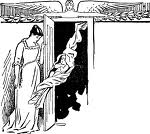
By Augustine Calmet.
Very clever physicians assert that in cases of the suffocation of the womb, a woman may live thirty days without breathing. I know that a very excellent woman was six-and-thirty hours without giving any sign of life. Everybody thought she was dead, and they wanted to enshroud her, but her husband always opposed it. At the end of thirty-six hours she came to herself, and has lived a long time since then. She told them that she heard very well all that was said about her, and knew that they wanted to lay her out; but her torpor was such that she could not surmount it, and she should have let them do whatever they pleased without the least resistance.
This applies to what St. Augustine says of the priest Pretextas, who in his trances and swoons heard, as if from afar off, what was said, and nevertheless would have let himself be burned, and his flesh cut, without opposing it or feeling it.
Corneille le Bruyn, in his Voyages, relates that he saw at Damietta, in Egypt, a Turk whom they called the Dead Child, because when his mother was with child with him, she fell ill, and as they believed she was dead, they buried her pretty quickly, according to the custom of the country, where they let the dead remain but a very short time unburied, above all during the plague. She was put into a vault which this Turk had for the sepulture of his family.
Towards evening, some hours after the interment of this woman, it entered the mind of the Turk her husband, that the child she bore might still be alive; he then had the vault opened, and found that his wife had delivered herself, and that his child was alive, but the mother was dead. Some people said that the child had been heard to cry, and that it was on receiving intimation of this that the father had the tomb opened. This man, surnamed the Dead Child, was still living in 1677. Le Bruyn thinks that the woman was dead when her child was born; but being dead, it would not have been possible for her to bring him into the world. It must be remembered, that in Egypt, where this happened, the women have an extraordinary facility of delivery, as both ancients and moderns bear witness, and that this woman was simply shut up in a vault, without being covered with earth.
A woman at Strasburg, who was with child, being reputed to be dead, was buried in a subterranean vault; at the end of some time, this vault having been opened for another body to be placed in it, the woman was found out of the coffin lying on the ground, and having between her hands a child, of which she had delivered herself, and whose arm she held in her mouth, as if she would fain eat it.
Another woman, a Spaniard, the wife of Francisco Aravallos, of Suasso, being dead, or believed to be so, in the last months of her pregnancy, was put in the ground; her husband, whom they had sent for from the country, whither he had gone on business, would see his wife at the church, and had her exhumed: hardly had they opened the coffin, when they heard the cry of a child, who was making efforts to leave the bosom of its mother.
He was taken away alive and lived a long time, being known by the name of the Child of the Earth; and since then he was lieutenant-general of the town of Héréz, on the frontier of Spain. These instances might be multiplied to infinity, of persons buried alive, and of others who have recovered as they were being carried to the grave, and others who have been taken out of it by fortuitous circumstances. Upon this subject you may consult the new work of Messrs. Vinslow and Bruyer, and those authors who have expressly treated on this subject. These gentlemen, the doctors, derive from thence a very wise and very judicious conclusion, which is, that people should never be buried without the absolute certainty of their being dead, above all in times of pestilence, and in certain maladies in which those who are suffering under them lose on a sudden both sense and motion.
*******
This is taken from Phantom World, originally published in 1850.
Copyright © D. J. McAdam· All Rights Reserved